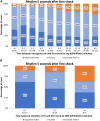Association Between Delay to First Shock and Successful First-Shock Ventricular Fibrillation Termination in Patients With Witnessed Out-of-Hospital Cardiac Arrest
- PMID: 39462804
- PMCID: PMC11872269
- DOI: 10.1161/CIRCULATIONAHA.124.069834
Association Between Delay to First Shock and Successful First-Shock Ventricular Fibrillation Termination in Patients With Witnessed Out-of-Hospital Cardiac Arrest
Abstract
Background: In patients with out-of-hospital cardiac arrest who present with an initial shockable rhythm, a longer delay to the first shock decreases the probability of survival, often attributed to cerebral damage. The mechanisms of this decreased survival have not yet been elucidated. Estimating the probability of successful defibrillation and other factors in relation to the time to first shock may guide prehospital care systems to implement policies that improve patient survival by decreasing time to first shock.
Methods: Patients with a witnessed out-of-hospital cardiac arrest and ventricular fibrillation (VF) as an initial rhythm were included using the prospective ARREST registry (Amsterdam Resuscitation Studies). Patient and resuscitation data, including time-synchronized automated external defibrillator and manual defibrillator data, were analyzed to determine VF termination at 5 seconds after the first shock. Delay to first shock was defined as the time from initial emergency call until the first shock by any defibrillator. Outcomes were the proportion of VF termination, return of organized rhythm, and survival to discharge, all in relation to the delay to first shock. A Poisson regression model with robust standard errors was used to estimate the association between delay to first shock and outcomes.
Results: Among 3723 patients, the proportion of VF termination declined from 93% when the delay to first shock was <6 minutes to 75% when that delay was >16 minutes (Ptrend<0.001). Every additional minute in VF from emergency call was associated with 6% higher probability of failure to terminate VF (adjusted relative risk, 1.06 [95% CI, 1.04-1.07]), 4% lower probability of return of organized rhythm (adjusted relative risk, 0.96 [95% CI, 0.95-0.98]), and 6% lower probability of surviving to discharge (adjusted relative risk, 0.94 [95% CI, 0.93-0.95]).
Conclusions: Every minute of delay to first shock was associated with a significantly lower proportion of VF termination and return of organized rhythm. This may explain the worse outcomes in patients with a long delay to defibrillation. Reducing the time interval from emergency call to first shock to ≤6 minutes could be considered a key performance indicator of the chain of survival.
Keywords: cardiopulmonary resuscitation; defibrillators; electric countershock; emergency medical services; heart arrest; out-of-hospital cardiac arrest; ventricular fibrillation.
Conflict of interest statement
None.
Figures





References
-
- Grasner JT, Wnent J, Herlitz J, Perkins GD, Lefering R, Tjelmeland I, Koster RW, Masterson S, Rossell-Ortiz F, Maurer H, et al. . Survival after out-of-hospital cardiac arrest in Europe: results of the EuReCa TWO study. Resuscitation. 2020;148:218–226. doi: 10.1016/j.resuscitation.2019.12.042 - PubMed
-
- Weisfeldt ML, Sitlani CM, Ornato JP, Rea T, Aufderheide TP, Davis D, Dreyer J, Hess EP, Jui J, Maloney J, et al. . Survival after application of automatic external defibrillators before arrival of the emergency medical system evaluation in the resuscitation outcomes consortium population of 21 million. J Am Coll Cardiol. 2010;55:1713–1720. doi: 10.1016/j.jacc.2009.11.077 - PMC - PubMed
-
- Kitamura T, Kiyohara K, Sakai T, Matsuyama T, Hatakeyama T, Shimamoto T, Izawa J, Fujii T, Nishiyama C, Kawamura T, et al. . Public-access defibrillation and out-of-hospital cardiac arrest in Japan. N Engl J Med. 2016;375:1649–1659. doi: 10.1056/NEJMsa1600011 - PubMed
-
- Zijlstra JA, Koster RW, Blom MT, Lippert FK, Svensson L, Herlitz J, Kramer-Johansen J, Ringh M, Rosenqvist M, Palsgaard Moller T, et al. . Different defibrillation strategies in survivors after out-of-hospital cardiac arrest. Heart. 2018;104:1929–1936. doi: 10.1136/heartjnl-2017-312622 - PubMed
MeSH terms
LinkOut - more resources
Full Text Sources
Medical
Miscellaneous

